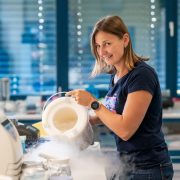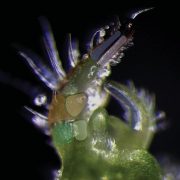
Recognizing Plant Physiology First Author: Chikako Kuwabara
Plant Physiology: Author Profiles
Recognizing Chikako Kuwabara, first author of: A model system for studying plant-microbe interactions under snow
Current position: Postdoctoral fellow at Graduate school of Agriculture, Hokkaido University, Japan
Education: Ph.D. in Bioscience from Hokkaido University
Non-scientific Interests:…

Recognizing Plant Physiology authors: Xiaoming Song
Plant Physiology, Plant Physiology: Author Profiles
Recognizing Plant Physiology first author Xiaoming Song, first author of Brassica carinata genome characterization clarifies U’s triangle model of evolution and polyploidy in Brassica
Current Position: Associate professor, School of Life Sciences, North China University of Science and Technology,…

Neolignans: treasure shields in seeds
The Plant Cell: In a NutshellKeiko Yonekura-Sakakibara, Masaomi Yamamura et al. identify factors that play essential roles in the biosynthesis of seed-coat protective neolignans. Plant Cell. http://bit.ly/3mseqae
By Keiko Yonekura-Sakakibara and Kazuki Saito,
RIKEN Center for Sustainable Resource Science
Background: Neolignans…

Taproot S5E3: Pre-Stressed Conditions: Epigenetics and Life as a Black Academic
Blog, The Taproot Season 5, The-Taproot0 Comments
/
In this episode, we talk with Dr. Thelma Madzima, Assistant Professor of Cell and Molecular Biology at the University of Washington, Bothell. A native of Zimbabwe, she received her Ph.D. in Plant Molecular and Cellular Biology from the University of Florida and went on to complete a postdoc with Karen…

Recognizing Plant Cell authors: Daniil Prigozhin
The Plant Cell, The Plant Cell: Author Profiles
Daniil M Prigozhin, first author of: Analysis of intraspecies diversity reveals a subset of highly variable plant immune receptors and predicts their binding sites
Current Position: Project Scientist at Lawrence Berkeley National Laboratory
Education: BA in Mathematics/Molecular and Cell Biology,…

Recognizing Plant Cell authors: Jae Young Choi
The Plant Cell, The Plant Cell: Author Profiles
Jae Young Choi, first author of Natural variation in plant telomere length is associated with flowering time
Current Position: Postdoc, Center for Genomics and Systems Biology at New York University (USA)
Education: Ph.D., Cornell University (USA)
Non-scientific Interests: I think I use to like…

Recognizing Plant Physiology authors: Eva Dvorak Tomastikova
Plant Physiology, Plant Physiology: Author Profiles
Eva Dvorak Tomastikova, first author of Polycomb Repressive Complex 2 and KRYPTONITE regulate pathogen-induced programmed cell death in Arabidopsis
Current Position: Postdoctoral Researcher, Centre of Plant Structural and Functional Genomics, Institute of Experimental Botany, Olomouc, Czech Republic
Education:…

Gene expression signatures during leaf development
The Plant Cell: In a NutshellMartinez et al. use laser capture microdissection and transcriptomic sequencing to explore how gene expression patterns regulate early morphogenesis of the compound tomato leaf. http://bit.ly/3nehiZu
By Ciera Martinez, University of California, Berkeley
Neelima Sinha, University of California,…

Plant point of view: Cactaceae
BlogWritten and Illustrated by Laura Mejia. Click on images to enlarge.
Mexico is one of the most important dryland regions of the world. Almost half of the cacti species found there are endemic, found nowhere else.
This beautiful review by Ramírez-Rodríguez et al., published in 2020 in Food Chemistry,…

